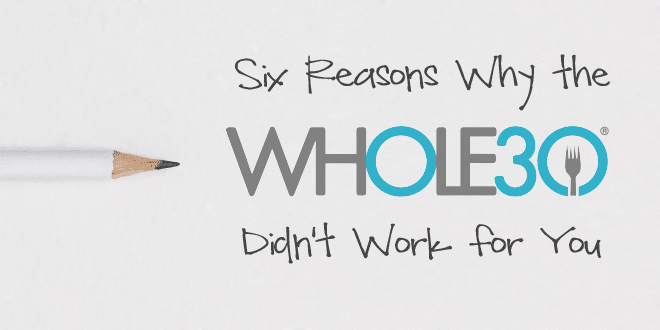The Whole30 has been around since July 2009, and we’ve read hundreds of thousands of I Am Whole30 stories. We’ve proven the program truly can reset your health, habits, and relationship with food, and the vast majority (88%, according to a 2016 survey of nearly 8,000 Whole30’ers) report the Whole30 really did change their life as promised.
But like anything, the Whole30 isn’t perfect. It’s as good as we can make it; designed to have the most significant impact on as many people as possible. We’ve tweaked it, adjusted it, and made it better as the years went on. But it still doesn’t work exactly the same for everyone, and it’s still not a miracle—despite the fantastic results some people do experience.
So when we hear from those who say the Whole30 “didn’t work” for them, we pay attention. We read their stories, ask questions of these participants, and over the years, have gathered some data on why “the magic” just didn’t come for these folks. (At least, not in the way they hoped it would. More on this below.)
If nothing else, the one thing we want you to take away from this article is that if the Whole30 didn’t work for you, you are not a failure, and there is nothing wrong with you. These things take time, practice, and often the right timing to fully manifest, and in some situations, diet alone simply isn’t going to get you there. But there may be reasons why your Whole30 just “didn’t work”… and there may be something you can do about it.
The Program Wasn’t Completed As Outlined
This is the most common reason why people report not seeing results, whether it’s their first program or their fourth. Maybe you didn’t finish your Whole30 at all, telling yourself if it wasn’t working by Day 14 or Day 21, it You followed the technical letter of the rules—but didn’t embrace the spirit or intention of the program. (See: dates with almond butter every night for dessert.) You “slipped” or “treated yourself,” because you had to/wanted to/figured it wouldn’t really matter. You adjusted the program to suit your cravings, your social life, or your idea of “healthy.” You only gave it two weeks before deciding it wasn’t working. You’ve done it before, and figured you could modify the program this time with the same results. You added intermittent fasting or a keto approach on top of your Whole30.
This is your opportunity to examine your experience, and be honest with yourself. Did you give the Whole30 program your full effort?
Action Item: If this is your context … try it again. Find the support you need to complete it. Get involved in the community. Subscribe to daily text messages from Melissa Urban for accountability and support. Use Whole30 Day by Day to track your progress. Go big, because you want the next 30 days to count, and really committing is the only way to know if the Whole30 really will change your life.
Thirty Days Wasn’t Long Enough
While radical health improvements can take place in just 30 days, when you put it into context, decades of less than healthy behavior often can’t compete with 30 days of Whole30. Fat adaption (teaching your body to use fat as fuel) takes time.* Stubborn medical issues, like psoriasis, migraines, chronic pain conditions, or autoimmune symptoms, often can’t be fully resolved in just a month. And an unhealthy psychological relationship with food—and the cravings, habits, and emotional ties that go along—are often the toughest battle to win.
*This is especially true if you’re coming from a diet that consists of highly processed carbohydrates. It can take several weeks before you learn to trust the “hungry” and “full” signals your body is sending you—and you may not have been eating enough in the beginning, because you were afraid of all that fat.
Many Whole30’ers report that they didn’t feel or see “the magic” until day 45, 60, or beyond. Whether you choose to extend your Whole30 or not is entirely up to you, but think about your results in terms of the context of your life, your health history, and your habits—and realize that maybe, you’ll need longer than just 30 days to see the ultimate results you were hoping for.
Action Item: If you’ve seen some progress but aren’t “there” yet, try adding another ten days (with the blessing of your healthcare provider) and see what happens, especially in the context of a chronic health condition. Or if cravings are still stubbornly present, try adding another ten days while reading Food Freedom Forever, and see if the extra time and a mindset shift helps.
Focus on Non-Scale Victories
You really, really wanted to lose weight on your Whole30, and you read tons of testimonials about effortless weight loss when nothing else worked—so of course, you expected this would be your outcome too. But you’re ten days in and stepped on the scale; or after 30 days, you either didn’t lose weight or didn’t lose as much as you had hoped. So you deemed the program a failure, because the number on the scale didn’t budge, or your pants still fit the same.
But were you paying attention to what else happened during your program? Are you falling asleep easier, staying asleep longer, waking more refreshed? Is your energy more consistent, or have you lost your usual mid-day slump? Has your pain decreased, has your skin improved, have your allergies diminished, are your sugar cravings easier to battle?
As we’ve written about so many times, the scale (and your body) aren’t the only measure of Whole30 success—in fact, we’d venture to say it’s pretty far down the list of potential life-changing results. And being open to embracing all of the changes the program has to offer—both the expected and the unexpected, the large and the small—can open your eyes to the results you’ve actually achieved. So if you didn’t lose weight (or change one particular health factor as much as you were hoping), take a different approach and focus on all of the positive changes you have seen.
Action Item: Next round of Whole30, use Whole30 Day by Day to track your daily progress, including all of your NSV (non-scale victories). This journal, part handbook, part guided reflection, was designed specifically to help people squeeze as much juice out of their Whole30 as possible, and keep their minds off the scale.
You can also download and track your Non-Scale Victories with our free NSV Checklist.
Every Body Is Unique
You may never totally resolve certain issues during your Whole30, even if you really are doing it right… and sometimes, symptoms like bloating, gas, or joint pain actually gets worse on the program. This may be because you’re eating more (fill in food here) than is good for YOUR body, or because you still have some dietary triggers in your Whole30 meals. It’s common for people who suddenly start eating lots of raw veggies and probiotic-rich foods (think salads, kombucha, and drinkable soups) to experience digestive disruption as their body gets used to processing so much fiber, or for people who take the “healthy fats” thing too far (do you really need half a stick of butter in your coffee?) to experience things moving too quickly.
In addition, if you’re still eating eggs, nightshade vegetables, or nuts and seeds as part of your healthy Whole30 plan and are, in fact, sensitive to these foods too, you may find your joints still swell, your migraines still persist, or your eczema isn’t improving. If this is the case, either seek the help of a qualified RD to help you figure out what foods may be of issue, make sure most of your veggies are cooked versus raw, eliminate the highest FODMAP foods from your Whole30 for a week to see if that helps, or try to do some sleuthing on your own to see if you can tweak the Whole30 to make it work for you.
Action Item: Keep a loose food journal or the reflections section of Whole30 Day by Day, writing down the foods you ate and beverages you drink. See if there is a pattern, like “Every time I eat a big salad for lunch, I’m bloated the rest of the day.” Use this information to adjust your Whole30 meals in a way that makes you feel your best.
Examine Other Lifestyle Factors
If you came to the Whole30 eating a diet rich in highly processed foods, we’d be stunned if the Whole30 didn’t make a huge impact on how you look, how you feel, and your quality of life. Stunned. But if you came to us from a Paleo or Primal-style diet, have done multiple rounds of Whole30 with no additional improvements, or saw no changes whatsoever after your “I really, truly committed” first Whole30, you know what that tells us? Diet isn’t your only (or biggest) problem.
If you’re experiencing a huge amount of life-stress (new baby, death in the family, other emotional stress), working the night shift, recovering from an injury or illness, or over-training given your capacity to recover (CrossFit six days a week), you may not see the benefits of your Whole30… unless the only benefit you’re looking for is “keeping you from TOTALLY falling apart” or “keeping things from getting even worse.” Because sometimes, the best thing a Whole30 can do for you is let you feel in control of one area of your life, when it feels like everything else is falling apart. (Which is a huge benefit… but does require a shift in perspective.)
Action Item: Look at your lifestyle factors and see if there are things you can moderate, eliminate, or simply process more effectively through talking, meditation, or therapy. Decide whether the timing of your Whole30 was off and you need to give it another shot when things have settled down a bit, or whether you can see the Whole30 really was working under the surface, just in a more subtle way than you imagined.
Diet Can’t Fix Everything
This is a difficult one to tell people, because we hear extrordinary Whole30 testimonials every day. “The Whole30 made my hot flashes disappear!” “The Whole30 cured my migraines!” “My rheumatoid arthritis symptoms are gone!” So why didn’t this happen to you?
We understand how hard it is to see other people “just like you” experiencing the results you desperately hoped to see. But remember, no one is just like you. Your health history, diet history, historical access to quality health care and health care practitioners, genetics, lifestyle, age, sex, and environment all meld together to form a unique situation: YOU. Which means the same protocol applied to two people with the same conditions can yield dramatically different results.
Unfortunately, even a dietary intervention as good as the Whole30 can’t always do everything you want it to do. In fact, you could pile a Whole30 on top of sleeping ten hours a night on top of smart exercise on top of stress management… and that still might not totally “fix” you. You may simply require a more targeted intervention, utilizing specific lab work, targeted supplements, and a professionally-designed protocol designed just for you and your unique context. (And if cravings or your relationship with food remains the issue, try talking it through with a trained counselor, to see if you can identify underlying issues keeping you stuck in your current food cycle.)
Of course, this doesn’t mean diet, sleep, exercise, and stress management don’t matter. In fact, in this situation, a Whole30-style diet is a prerequisite for the work you’ll do with your qualified healthcare practitioner, and they’ll be thrilled when you show up saying, “I’m doing the Whole30,” because it’s one less step they’ll have to walk you through.
Where Should You Start when Diet and Lifestyle Aren’t Enough?
Under the guidance of your healthcare provider, there are several “next steps” you can take.
Here’s how Dr. Rick Henriksen and Dr. Kirin Escher, both MDs and Whole30 Certified Coaches help their patients identify factors outside of the Whole30 that impact their results. Keep in mind, the specific biomarkers needed to get “the full picture” will depend on your medical concerns.
Consider asking your provider to run these lab tests
- Complete Blood Count (CBC): This checks specific markers that provide insight into anemia, infection, inflammation, and other disease processes. Consider adding ferritin, a marker for iron storage capacity, to this for more context and to help diagnose iron deficiency or iron overload.
- Complete Metabolic Panel (CMP): This evaluates your glucose, electrolyte balance, kidney and liver function. Consider adding hemoglobin A1c and fasting insulin to this for more insight into your metabolic health.
- Inflammatory Markers: These are specific markers that, if positive, can indicate or lead to a diagnosis of an inflammatory (or autoimmune) disease process. This includes Antinuclear antibody (ANA), C-reactive protein (CRP), and Erythrocyte Sedimentation Rate (ESR).
- Thyroid panel: If you’re still fatigued, feel constipated, swollen or other signs that may indicate a thyroid issue, run a full thyroid panel that includes free T3, free T4, reverse T3 and thyroid antibodies (TPO-Ab and Tg-Ab) in addition to TSH.
- Advanced Stool Testing: Take a good look into your gut microbiome. This test provides immediate, actionable clinical information for the management of gut health, which in turn affects your whole health.
- Dig Deeper: This is the important part. Most appointments with doctors last 10 minutes or less. This is often not enough time to really figure out the root cause of your medical issues or how to optimize your health. Find a provider who will have a deeper, more thorough conversation about what’s going on.
- Follow up: Don’t just talk to your doctor when you’re sick. Create a long-term, two-way relationship with a doctor that really knows you and is invested in your overall health. This may come in the form of follow up labs or simply a phone call/text message.
Action Item: Connect with a good functional medicine practitioner through Parsley Health, Re-Find Health or the IFM, and let them guide you the rest of the way towards your own personal definition of health, wellness, and vitality.
The Good News
After all this, there is good news. If you’ve done the Whole30 with not-so-stellar results, go back and reevaluate your efforts, and your outcome. Perhaps you’ll see your program in a new light—or be motivated to try again. If you’ve got a complicated health history, don’t be discouraged! Armed with a healthy lifestyle (and perhaps the help of an experienced professional) you are already back on the road to recovery. Patience is key. Being kind to and forgiving of yourself is key. And focusing on the positive changes you are seeing could actually have the biggest impact on your perception of your Whole30 experience.















